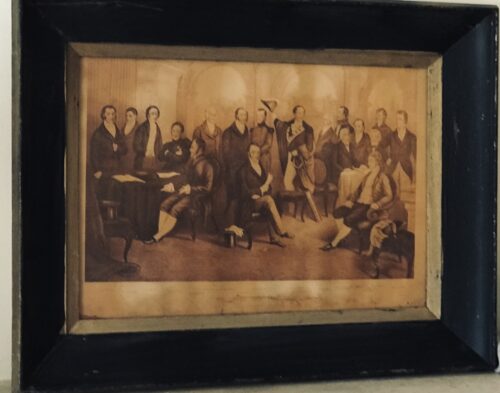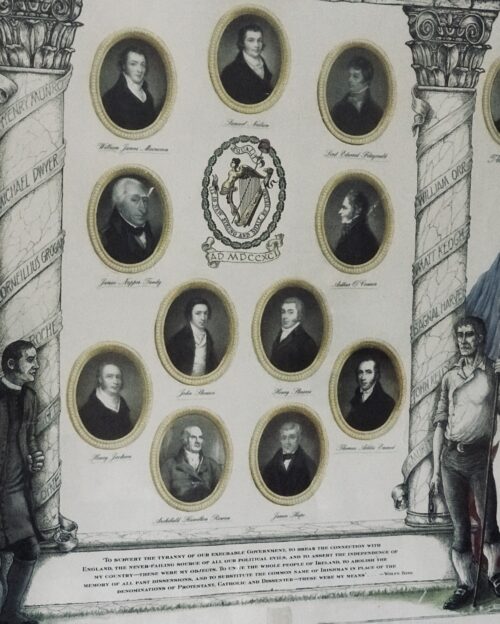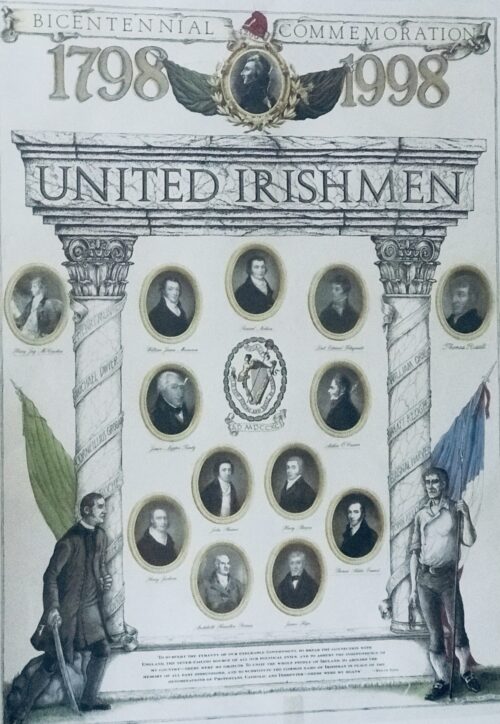
Background


Radicalisation


The Rebellion breaks out

Wexford, Ulster and Kilalla Bay


Aftermath





























Mick The Miller,as featured in this iconic advert, was the most famous greyhound of all time. He was born in 1926 in the village of Killeigh, County Offaly, Ireland at Millbrook House(only 5 miles from Tullamore), the home of parish curate, Fr Martin Brophy. When he was born Mick was the runt of the litter but Michael Greene, who worked for Fr Brophy, singled the little pup out as a future champion and insisted that he be allowed to rear him. With constant attention and regular exercise Mick The Miller developed into a racing machine. His first forays were on local coursing fields where he had some success but he showed his real talent on the track where he won 15 of his first 20 races.
.jpg)
In 1929 Fr Brophy decided to try Mick in English Greyhound Derby at White City, London. On his first trial-run, Mick equalled the track record. Then, in his first heat, he broke the world record, becoming the first greyhound ever to run 525 yards in under 30 seconds. Fr Brophy was inundated with offers and sold him to Albert Williams. Mick went on to win the 1929 Derby. Within a year he had changed hands again to Arundel H Kempton and won the Derby for a second time.
Over the course of his English career he won 36 of his 48 races, including the Derby (twice), the St Leger, the Cesarewitch, and the Welsh Derby. He set six new world records and two new track records. He was the first greyhound to win 19 races in a row. Several of his records went unbroken for over 40 years. He won, in total, almost £10,000 in prizemoney. But he also became the poster-dog for greyhound racing. He was a celebrity on a par with any sports person, muscisian or moviestar. The more famous he became, the more he attracted people to greyhound racing. Thousands thronged to watch him, providing a huge boost to the sport. It is said that he actually saved the sport of greyhound racing.



Cockfighting is an illegal sport, it is still practised in Ireland, and shows no signs of dying out.
A cockfight is a blood sport where two cockerels are placed in a ring, called a ‘pit’, and fight one another, often until the death, for the entertainment of onlookers. Gambling also takes place at these events. Cathal O’Shannon talks to a man identified as Charlie, who trains cockerels, attends cockfights and also acts as an adjudicator at cockfighting matches. Charlie explains what happens at a cockfight, or ‘main’. The birds are placed in the pit and advance on one another. Men pick the birds up, or ‘haunt the cocks’, when one of the cockerels is injured, or when he goes outside the pit, and go back to their station again. The adjudicator then starts counting to 30. This gives the birds a brief rest before the next bout commences. When asked if he thinks that the metal spurs tied to the cockerels’ feet are cruel, he says "A cock can run if he likes...he can quit fighting." Contrary to popular opinion, Charlie does not believe the sport is a cruel one, as he loves the birds, and looks after them in the best way possible prior to a fight, "Get him cleaned up, and give him the sweet milk and the porridge, and get him dosed up again, a wee taste of rice, you get him closed...you put him on the bread then...give him three feeds...bread, and the whites of eggs, and spiced port wine or sherry." When there is a ‘main’ on, the news is spread by word of mouth, often less than 24 hours in advance. Cathal O’Shannon notes that the best place to find a cockfight is, ironically, often where there is a large police presence, such as a football match, a parade, or a Fleadh Cheoil. Any place where the police are too busy to notice. This report for Newsbeat was broadcast on 19 May 1967. The reporter was Cathal O’Shannon. ‘Newsbeat’ was a half-hour feature programme presented by Frank Hall and ran for 7 years from September 1964 to June 1971. ‘Newsbeat’ went out from Monday to Friday on RTE television and reported on current affairs and issues of local interest from around Ireland. The final programme was broadcast on the 11 June 1971. Origins : Co Laois Dimensions :60cm x 50cm 6kg









Worldwide Duty Free selling is a $70 billion business, but it has its origins in the mind of one Clare man. And like many innovations, the concept of duty free, which first came to Shannon Airport in 1952, was born of necessity.Today the global travel retail business is a firm fixture at airports across the world, and the concept has made a lot of money for a lot of people.But not for Brendan O’Regan, the man with the idea.
He was born into “the first generation of free Irish men” in relatively well-off surroundings in Sixmilebridge, Co Clare in 1917. His father, James, was chairman of Clare County Council and a successful businessman. The family was in the hotel business, and for a time leased the renowned Falls Hotel in Ennistymon and the Old Ground in Ennis. Sent as a boarder to Blackrock College in Dublin in 1931, O’Regan enjoyed early renown when he requested that the college, which by then had given up on the camán, field a hurling team in the Leinster Colleges cup.
His next step after school was training in hotel management, an interest that brought him to Germany, France and the UK, before coming home to run The Falls. He then moved to the ailing St Stephen’s Green club in Dublin, before being appointed catering comptroller at Foynes flying boat base in Co Limerick, then a refuelling point for transatlantic seaplanes.
It was here his passion for travel took off, but it was his next move that sealed his legacy.
Rineanna on the Shannon estuary in Co Clare, chosen by then taoiseach Seán Lemass as the site for a new airport for both sea and land planes, opened in October 1945, when the first transatlantic commercial air service from Boston landed there. It soon became Europe’s most important transatlantic airport, handling more than 100,000 passengers in 1946, its first full year of operation.
When O’Regan joined the nascent airport, its future was by no means secure. The imminent arrival of jet planes, which meant US planes would no longer have to stop in Shannon to refuel, was of concern, while the political apparatus of the day favoured focusing efforts on one airport in Dublin.
Fearing “economic annihilation” for the new airport, O’Regan sought a new venture that would help secure its future. Inspiration struck when he was returning home by sea from a visit to the United States, arranged under the Marshall Plan to allow the Irish government to study US tourism.
As told in the recently published book Brendan O’Regan: Irish Innovator, Visionary and Peacemaker by Brian O’Connell and Cian O’Carroll, O’Regan had a “eureka” moment on board.
“I saw the shop that was selling duty-free goods and my brain said to me: “If they can do it when you are crossing the sea in a boat, you can surely be able to do [it] when you land for the first time.”
He had to convince the Department of Industry and Commerce and the Revenue Commissioners of the merits of forgoing tax on the sale of goods, while local traders also opposed the move.
Nonetheless, O’Regan got the go-ahead and by July 1950 he had set up an operation in a timber hut outside the terminal, selling whiskey for $1.50 a bottle. The following year, the first duty-free shop in the world opened, with a bottle of whiskey on sale for just 30s, compared with 10s 6d in a regular shop, while in 1954 a mail order service was included. It went on to become a vast operation, mailing to locations all around the world, quality items such as crystal, china, fashionable clothing and jewellery.
The concept soon caught on. In 1957 Amsterdam became the next airport to open a duty free, with the concept making its way across the Atlantic in 1962. Prince Philip was an early admirer of the concept, and he wanted it extended to all the UK’s international airports.
O’Regan also inspired philanthropist Chuck Feeney, who took the idea of duty free and galloped ahead with it, founding Duty Free Shoppers Group (DFS) in Hawaii in 1962, which later became the largest duty-free retailer in the world.
These years also saw the invention of Irish coffee, after O’Regan asked chef Joe Sheridan to “come up with something special” to warm up transatlantic passengers tired and cold after their trip.
But duty free was only part of the equation. O’Regan’s big dream was to position Shannon as the European manufacturing basis for US companies, and to bring employment and prosperity to the region.

Shaped by the devastating impact poverty and emigration had on the county of his birth, O’Regan often repeated his father’s maxim, that “the most important thing about life is to create work for others, if you can”.
In the 1950s, the post-war boom that lifted the US, Europe and the UK had missed Ireland, and emigration was running at the highest level since independence.
So O’Regan didn’t stop at the duty free.
In 1951, he established the Shannon College of Hotel Management, which is still operating today and the graduates of which have managed the world’s top hotels, while he also leveraged the area’s potential as a tourist hub. He identified the potential of Bunratty Castle as a tourist attraction and, with the co-operation of its owner, Lord Gort, it was renovated and opened to the public in 1960, with the first medieval banquet held shortly thereafter. O’Regan later chaired Bord Fáilte.
“He was very much a leader and innovative in the sense that he thought up ideas himself,” recalls O’Carroll, who worked alongside O’Regan as estates manager in the Shannon Free Airport Development Company Limited (SFADCO). “He would work very intensively until the project was launched, and then he would go on to the next project”.
It was a time of “brainstorming picnics”, and consultancy reports, to try and hit on a new idea.
“They were great times,” says O’Carroll. “If an idea came up, and it was any way worthwhile, it would stand a very good chance of implementation.”
The big move came in the establishment of the Shannon Free Zone, the world’s first free trade zone, in 1959, overseen by SFADCO. It operated a licensing system, offering qualifying companies a corporation tax rate of just 10 per cent; a model that would later be taken up by the IFSC.
O’Regan’s idea, inspired by the Free Zone in Colon, Panama, was greeted with much scepticism initially, but his ability to build good relationships, particularly with those in government, helped secure the initiative.
“He had the ability to short-circuit a lot of things in terms of procedures in getting approval,” says O’Carroll, adding that “this clearly annoyed civil servants at the time.”
Indeed his initials, BOR, in Shannon came to mean “Bash on regardless”.
So, on an “if you build it they will come” ambition, SFADCO set about building factories – without any tenants. A Dutch piano manufacturer owned by Johan J Rippen was the first real enterprise to come to Shannon, followed by Sony, and diamond company De Beers in 1960.
O’Regan also ramped up the region’s renown as a tourist destination, using his tools of persuasion to garner investment.
When Bernard McDonough, a wealthy Irish-American industrialist pulled out of a planned ball-bearing factory in the Shannon Free Zone, O’Regan told him about a nearby castle that was for sale. He took the bait and bought it; in 1963 Dromoland Castle opened as a five-star hotel. McDonough would later open a further three hotels in the area.
When he heard of a plan by German investors to acquire the land leading to the Cliffs of Moher, he rang then Clare county manager Joe Boland, who subsequently got the county council to buy it.
During the 1970s he moved away from his formal roles in Shannon, and turned his attention to the peace process, founding Co-operation North (now Co-operation Ireland) in 1979. He died in 2008, and a bronze bust sculpture was unveiled at Shannon Airport in May 2017 to mark the centenary of his birth.
A man of his time – as O’Carroll recalls, an “infinitely simpler” time – he nonetheless left a significant legacy.
As described when receiving an honorary degree from the National University of Ireland in 1978: “Rare is the man of whom it can be justly said that he transformed the social, economic and industrial life of a whole region”
The Shannon project was not just about creating jobs; it was also about providing homes for the workers who flocked there.
By the late 1950s the housing issue, which had plagued the development of the hub since the early days, was becoming a crisis. So, in 1960, a proposal was tabled for the creation of a new town; an innovation without precedent in post-war Ireland.
Inspired by the British new towns that arose after the war, including Crawleyin Sussex and Stevenage in Hertfordshire, Brendan O’Regan and his team sought to build a new hub for workers of the airport and the industrial zone.
The creation of the first new town in the history of the State was not without challenges; there were political ructions as to who would oversee the project – the government or SFADCO – while residents of nearby Limerick city accused Brendan O’Regan of “empire building”, as they rued the fact that the development did not happen in Limerick instead.
Nonetheless, by 1962 the first residents were moving in, all of whom were tenants of SFADCO and who had to work either in the airport or industrial area to qualify for affordable housing.
As SFADCO estates manager Cian O’Carroll recalls, building the houses so close to a place of huge employment was key, as was the fact that units were small – but even larger families were catered for.
“We often let them two houses and knocked them together,” he says.
Also key to its success was the fact that housing was affordable, and graded and related to people’s incomes. After some time a tenant purchase scheme was introduced, allowing people to buy their homes outright.
Today the town is home to some 10,000 residents, and remains one of the few examples of a new planned town in Ireland.
“It hasn’t grown as much as people might have expected, but it has its own social and economic viability,” says O’Carroll.
As to why subsequent governments haven’t looked to emulate the success of Shannon – particularly given our housing shortages – O’Carroll suggests it’s due to an ideological shift away from the State doing things directly themselves, instead encouraging the private sector to do the same through tax incentives and other methods.
“It’s a shame,” he says.

